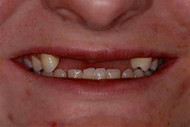Common causes of teeth loss
Adults usually lose their teeth due to gum disease.
Gingivitis is the first stage of periodontal disease when the gums become inflamed and tender.
Periodontitis happens when the infection and inflammation worsen, causing the gums to pull away from tooth enamel, resulting in bone loss and eventually leading to loose or falling out teeth.
Symptoms
Periodontal (gum) disease manifests itself in the following ways:
- Breath problems (halitosis)
- There's a bad taste in my mouth that won't go away.
- Gums that are red or swollen
- Gums that are tender or bleeding
- The recession of the gums
- Sensitive teeth
- When chewing, there is pain
- Loose teeth
- Gums that are receding from the teeth
- The way your teeth fit together changes when you bite
- Modifications in partial denture fit
- Loss of teeth (severe cases)
Causes
Plaque buildup on the teeth causes periodontal disease (gum disease). Bacteria on the teeth can build up and form a film in the mouth (plaque). Tartar (calculus) forms when plaque hardens, and it can accumulate and spread below the gum line.
A variety of factors can contribute to periodontal disease, including:
- Tobacco use (biggest risk factor)
- Oral hygiene issues
- Heredity
- Diabetes
- Stress
- Crooked teeth
- AIDS and other immunodeficiencies
- Fillings with flaws
- Dry mouth medications should be avoided at all costs
- Bridges that are no longer functional
- Hormonal changes in women, such as pregnancy, menopause, or oral contraceptive use
Diagnosis
Periodontal disease is diagnosed by a dentist or dental hygienist based on the patient's medical history and a thorough mouth examination.
X-rays may be taken to determine the extent of the gum disease and whether there is any bone loss.
Patients with advanced gum disease may be referred to a periodontist (a dentist specializing in diagnosing and treating gum disease), who may have more treatment options.
Treatment
Gingivitis and periodontal disease are treated with the following methods:
- Deep cleaning beneath the gums of the root surfaces
- Medications that must be taken orally or placed directly under the gums.
- Surgery to correct a problem
Prevention
Maintain the health of your teeth and gums while preventing or controlling periodontal disease:
- Use fluoride toothpaste twice a day.
- Use a special brush, wooden or plastic pick, or a water flosser as a dental professional recommends to help remove bacteria between teeth that cause gum disease.
- If you have any of the warning signs or risk factors for gum disease, you should see a dentist at least once a year or more often.
- Smoking is not permitted.
When should you see a dentist?
Checkups should be done regularly, as directed by your dentist. Make an appointment with your dentist as soon as possible if you notice any periodontitis symptoms. The earlier you seek treatment, the better your chances of reversing periodontitis damage. For those scared of the dentist but wanting to show off their smile we offer clip-on veneers allowing you to achieve a straighter and whiter smile from the comfort of your own home.
Frequently Asked Questions
Is an Antibiotic Required Before a Dental Procedure?
Doctors and dentists sometimes prescribe antibiotics before certain dental procedures. Antibiotic prophylaxis is the term for this. But why do healthcare providers recommend going the extra mile?
We all have bacteria in our mouths, and various dental treatments—as well as daily habits such as chewing, brushing, and flossing—can allow bacteria to enter the bloodstream (bacteremia).
Usually, this isn't a big deal. These bacteria cannot harm you if you have a healthy immune system. However, there is concern that bacteremia may cause infection elsewhere in the body in some people.
If you have any questions about antibiotic prophylaxis, talk to your dentist.
What Should You Do If You Have a Tooth Loss?
You should call your dentist right away to set up a visit. Dentists can sometimes save a lost tooth by replanting it in the socket, especially if the tooth has completely fallen out (including the root).
If that isn't an option, your dentist can help you fill the gap left by the permanent tooth with a tooth-colored metal and porcelain crown, a dental implant, or a bridge.
Just don't give up: Because the space puts pressure on the surrounding teeth, leading to fractures from overuse, losing one tooth increases your chances of losing more teeth.
You're also more likely to get infections and other dental problems, which can lead to painful and expensive procedures in the future.
Who is susceptible to tooth decay?
Tooth decay is caused by a lack of dental hygiene and the consumption of too many sugary or starchy foods and beverages.
Some people are more susceptible to tooth decay than others, such as those who:
You don't have enough saliva because of medicines, certain diseases, or cancer treatments.
There isn't enough fluoride in your diet.
Are still relatively young. Bottle-drinking babies and toddlers are at risk, especially if they are given juice or have bottles at bedtime. As a result, sugars are exposed to their teeth for extended periods of time.
Are in their later years. Many older adults suffer from receding gums and increased tooth wear. These factors increase the risk of decay on their teeth's exposed root surfaces.

 UK
UK
 USA
USA
 Australia
Australia

